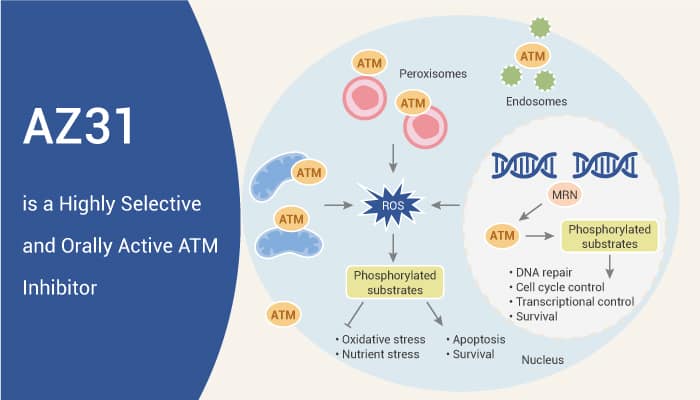Ataxia telangiectasia mutated (ATM) is an ATP-dependent phosphatidylinositol 3-kinase-related kinase (PIKK) serine/threonine protein kinase. ATM is related to ATR, DNA-PKcs, mTOR, SMG1 and the non-enzymatic TRRAP within this enzyme family. Importantly, ATM is a central player in the mitotic DNA damage response (DDR), increasing the response to DNA double-strand breaks (DSBs). Besides, activation of ATM by ionizing radiation results in the activation of signal transduction pathways that induce cell cycle arrest. In addition, ATM plays an important role in activating cell cycle checkpoints. It also functions as an active barrier against genome instability and tumorigenesis in replicating cells. Furthermore, ATM is auto-phosphorylated when recruited to sites of DSBs by the DNA end-tethering MRE11-RAD50-NBS1 (MRN) complex. This in turn leads to phosphorylation of H2AX at serine 139 (γ-H2AX), which initiates the assembly of DNA repair components at the DSB and amplifies the DDR.
AZ31 is a potent, highly selective, and orally active ATM inhibitor.

However, it shows excellent selectivity over ATR (>500-fold) and excellent PIKK-family selectivity and pan-kinase selectivity. AZ31 blocks the DDR and radiosensitized glioblastoma multiforme (GBM) cells in vitro. Meanwhile, human glioma cell lines with p53 mutations and defects in p21 induction are more sensitive to AZ31 radiosensitization than normal cells. Moreover, AZ31 also effectively blocks phosphorylation of a panel of ATM targets including p53-S15, KAP1-S824, and ATM auto-phosphorylation at S1981. At the same time, AZ31 shows low blood-brain barrier (BBB) permeability rendering it unsuitable for systemic treatment of mouse brain tumors. In addition, AZ31+Irinotecan is effective at reducing tumor growth in tumors that exhibited resistance to irinotecan in the colorectal cancer patient-derived xenograft (PDX) model.
To sum up, AZ31 is a potent, highly selective, and orally active ATM inhibitor, and is also a potent radiosensitizer in vitro.
References:
[1] Jeremy Karlin, et al. Mol Cancer Ther. 2018 Aug;17(8):1637-1647.
[2] Sébastien L. Degorce, et al. J Med Chem. 2016, 59, 13, 6281-6292.
[3] Erika S Dahl, et al. Front Oncol. 2017 Nov 29;7:291.